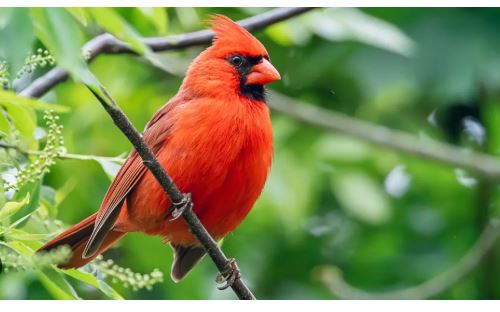
Cardinal birds captivate with their vibrant plumage, showcasing brilliant shades of red, blue, and yellow that illuminate their surroundings. Their feathers, often vivid and derived from carotenoid-rich diets, create a striking contrast against green foliage or arid landscapes. With sturdy, conical bills and compact bodies, these birds exude a bold, charismatic presence.
Their appearances vary from fiery, uniform colors to intricate patterns with contrasting wingbars or facial masks, often accentuated by distinctive crests in some species. The vivid hues, particularly reds, glow intensely in sunlight, while others display subtler tones of orange or blue, adding to their diverse appeal. These visual traits make them a standout in any habitat.
Found across diverse environments, from lush forests and wetlands to dry scrublands and suburban gardens, these birds thrive in a range of climates. Their adaptability allows them to inhabit both dense woodlands and open, human-altered spaces, where their bright colors either blend with or pop against their surroundings.
Their robust builds, often with short tails and strong beaks, reflect their seed-crushing diet and energetic behaviors. Some sport elegant crests or bold markings that enhance their expressive, cardinal-like charm, making them a favorite among observers for their lively presence.

Cardinal Birds
Northern Cardinal (Cardinalis cardinalis)
The Northern Cardinal is a striking songbird with a vibrant red body, black face mask, and prominent crest in males, while females are a warm reddish-brown with red accents on the wings, tail, and crest. Its 8.3–9.3-inch frame and bright coral-colored, conical bill create a bold, iconic look. The male’s crimson plumage, derived from carotenoid-rich foods, glows vividly, while the female’s subtler hues offer elegant contrast. Native Area: Southeastern Canada, eastern United States to Texas and Arizona, Mexico, Belize, and Guatemala, in woodlands, gardens, shrublands, and wetlands.
Pyrrhuloxia (Cardinalis sinuatus)
The Pyrrhuloxia, or Desert Cardinal, features a gray body with a red crest, face mask, and underparts in males, while females are grayer with subtle red tinges. Its 8.3–8.7-inch frame, short crest, and curved, parrot-like bill give it a distinctive, less vibrant look than its northern cousin. The red accents pop against the gray plumage, suited for arid landscapes. Native Area: Southwestern United States (Arizona, New Mexico, Texas) and northern Mexico, in thorn scrub, mesquite savannas, and desert washes.
Vermilion Cardinal (Cardinalis phoeniceus)
The Vermilion Cardinal boasts a brilliant red body, crest, and face in males, with blackish wings and a slender, conical bill. Females are grayish-brown with pinkish-red underparts. Its 7.5–8.3-inch frame is sleek, with the male’s vivid red plumage creating a stunning contrast against darker wings. Native Area: Northern South America, from Venezuela to Colombia, in dry scrublands, farmlands, and riverine thickets.
Red-crested Cardinal (Paroaria coronata)
The Red-crested Cardinal features a vibrant red head and crest, white underparts, and grayish wings and back. Its 7.5-inch frame and slender, gray bill give it a sleek, elegant appearance. The bright red crest contrasts sharply with the white belly, creating a striking, cardinal-like look despite its tanager classification. Native Area: South America, including Brazil, Argentina, Paraguay, Uruguay, and Bolivia, with introduced populations in Hawaii and Puerto Rico, in urban areas, grasslands, and forest edges.
Yellow Cardinal (Gubernatrix cristata)
The Yellow Cardinal sports a bright yellow body with a black face mask and crest in males, while females are duller with olive-yellow tones. Its 7.9-inch frame and conical bill enhance its vibrant, crested appearance. The yellow plumage, rare among cardinals, glows vividly in open landscapes. Native Area: South America, from southern Brazil to Argentina and Uruguay, in grasslands, savannas, and shrubby areas.
Black-faced Cardinal (Paroaria nigrogenis)
The Black-faced Cardinal has a vivid red body and crest with a stark black face mask, giving it a dramatic look. Its 7.5-inch frame and slender bill complement the bright red plumage, which contrasts sharply with the black face and grayish wings. Native Area: South America, from Colombia to Venezuela and Bolivia, in tropical forests, riverine thickets, and wetlands.
Masked Cardinal (Paroaria nigrogenis)
The Masked Cardinal, closely related to the Black-faced Cardinal, features a bright red body and crest with a bold black mask across the face. Its 7.5-inch frame and gray bill create a sleek, vibrant appearance, with the red plumage standing out vividly against the black and gray accents. Native Area: South America, from Venezuela to northern Brazil, in lowland forests, swamps, and river edges.
Red-capped Cardinal (Paroaria gularis)
The Red-capped Cardinal boasts a scarlet-red head and throat, white underparts, and blackish upperparts. Its 6.5–7-inch frame and slender bill give it a compact, striking look, with the red cap glowing brightly against the contrasting body. Native Area: South America, from Bolivia to Brazil and Peru, in wetlands, riverbanks, and flooded forests.
Red-hooded Tanager (Piranga rubriceps)
The Red-hooded Tanager, a Cardinalidae species, features a crimson-red head and throat in males, with olive-green upperparts and yellow underparts. Its 7-inch frame and stout bill create a vivid, cardinal-like appearance, though females are duller with grayish heads. Native Area: Andean mountain range from Colombia to Peru, in tropical and subtropical cloud forests.
Flame-colored Tanager (Piranga bidentata)
The Flame-colored Tanager has a bright red body in males, with black wings, white wingbars, and distinctive ear patches. Females are yellow with olive upperparts. Its 7.3-inch frame and pointed bill enhance its vibrant, cardinal-like look. Native Area: Southern United States to northern Panama, in mountain forests and woodlands.
Red-headed Tanager (Piranga erythrocephala)
The Red-headed Tanager features a bright red head and throat in males, with olive-green upperparts and yellow underparts. Its 6.7-inch frame and slender bill give it a sleek, colorful appearance, while females are duller with grayish heads. Native Area: Western Mexico, in tropical and subtropical montane forests.
Scarlet Tanager (Piranga olivacea)
The Scarlet Tanager boasts a scarlet-red body in males, with jet-black wings and tail, and a slender bill. Females are yellow with olive upperparts. Its 7-inch frame and vibrant red plumage create a stunning, cardinal-like appearance during breeding season. Native Area: Eastern North America, wintering in northwestern South America, in deciduous forests and suburban gardens.
Blue Grosbeak (Passerina caerulea)
The Blue Grosbeak, a Cardinalidae species, features a vibrant blue body in males, with chestnut wingbars and a large, conical bill. Females are warm brown with subtle blue tinges. Its 6.7–7.5-inch frame and bold blue plumage give it a cardinal-like vibrancy. Native Area: Southern United States to Central America, in shrubby fields, forest edges, and grasslands.
Indigo Bunting (Passerina cyanea)
The Indigo Bunting sports a brilliant blue body in breeding males, with a small, conical bill and compact 5-inch frame. Females are brownish with faint blue tinges. The vivid blue plumage, though not red, echoes the bold coloration of cardinals. Native Area: Eastern North America, wintering in Central America and the Caribbean, in fields, brushy areas, and forest edges.
Painted Bunting (Passerina ciris)
The Painted Bunting is a dazzling Cardinalidae species with males displaying a vibrant blue head, red underparts, green back, and red eye ring, creating a rainbow-like effect. Females are a vivid green, unlike the typical brown of other cardinals. Its 5–5.5-inch frame and small, conical bill give it a compact, jewel-like appearance. Native Area: Southeastern United States, wintering in Central America and the Caribbean, in shrubby thickets, woodlands, and coastal scrub.
Lazuli Bunting (Passerina amoena)
The Lazuli Bunting boasts a brilliant orange breast and blue head in males, with a grayish back and white wingbars. Females are brown with subtle blue tinges. Its 5–5.5-inch frame and short, conical bill create a vibrant, cardinal-like look, with the blue and orange hues glowing vividly. Native Area: Western United States, wintering in Mexico, in grasslands, brushy hillsides, and riparian areas.
Rose-breasted Grosbeak (Pheucticus ludovicianus)
The Rose-breasted Grosbeak features a black head and back in males, with a vivid red breast and white underparts, accented by a large, pale conical bill. Females are brown with streaked underparts. Its 7.5–8.5-inch frame offers a striking, cardinal-like contrast of colors. Native Area: Eastern North America, wintering in Central and South America, in deciduous forests, woodlands, and gardens.
Black-headed Grosbeak (Pheucticus melanocephalus)
The Black-headed Grosbeak has a black head, wings, and tail in males, with an orange-cinnamon breast and yellow underparts. Females are brown with subtle orange tones. Its 7.5–8.3-inch frame and thick, conical bill give it a robust, cardinal-like appearance with vibrant hues. Native Area: Western North America, wintering in Mexico, in pine-oak woodlands, forests, and suburban areas.
Northern Grosbeak (Pheucticus aureoventris)
The Northern Grosbeak sports a black head and back in males, with a bright yellow belly and subtle orange tinges on the breast. Females are brown with streaked underparts. Its 8–9-inch frame and large, conical bill enhance its bold, cardinal-like look. Native Area: South America, from Colombia to Argentina, in subtropical forests, woodlands, and savannas.
Evening Grosbeak (Coccothraustes vespertinus)
The Evening Grosbeak features a vibrant yellow body in males, with a black head, wings, and tail, accented by white wing patches. Females are grayish with yellow tinges. Its 7.5–8.5-inch frame and massive, conical bill give it a striking, cardinal-like appearance. Native Area: North America, from Canada to Mexico, in coniferous forests and suburban feeders.
Crimson-collared Grosbeak (Rhodothraupis celaeno)
The Crimson-collared Grosbeak boasts a deep red to crimson body in males, with black wings, head, and tail. Females are olive-green with darker wings. Its 8–8.5-inch frame and thick, conical bill create a bold, cardinal-like look with rich red hues. Native Area: Eastern Mexico, in humid forests, shrublands, and coastal thickets.
Yellow Grosbeak (Pheucticus chrysopeplus)
The Yellow Grosbeak has a bright yellow body in males, with black wings and white wing patches, and a blackish face. Females are duller with olive-yellow tones. Its 8–9-inch frame and large, conical bill give it a vibrant, cardinal-like appearance. Native Area: Western Mexico to Guatemala, in pine-oak forests, woodlands, and scrublands.
Red-and-black Grosbeak (Periporphyrus erythromelas)
The Red-and-black Grosbeak features a bright red head and underparts in males, with jet-black upperparts and wings. Females are brown with red tinges. Its 7.5–8-inch frame and stout bill enhance its cardinal-like vibrancy and contrast. Native Area: Northern South America, from Venezuela to Colombia, in humid forests and forest edges.
Blue-black Grosbeak (Cyanocompsa cyanoides)
The Blue-black Grosbeak sports a deep blue-black body in males, with a slightly glossy sheen, and a large, conical bill. Females are rich brown. Its 6.5–7-inch frame gives it a compact, cardinal-like appearance with bold coloration. Native Area: Central and South America, from Mexico to Brazil, in lowland forests, thickets, and plantations.
Ultramarine Grosbeak (Cyanocompsa brissonii)
The Ultramarine Grosbeak features a vibrant ultramarine-blue body in males, with darker wings and a thick, conical bill. Females are brown with subtle blue tinges. Its 6–6.5-inch frame offers a striking, cardinal-like blue hue. Native Area: South America, from Brazil to Argentina, in savannas, grasslands, and forest edges.
Blue Bunting (Cyanocompsa parellina)
The Blue Bunting has a rich blue body in males, with a brighter blue head and darker wings, and a small, conical bill. Females are warm brown. Its 5.5–6-inch frame creates a compact, cardinal-like appearance with vivid blue plumage. Native Area: Central America, from Mexico to Nicaragua, in lowland forests, shrublands, and thickets.
Hepatic Tanager (Piranga flava)
The Hepatic Tanager features a reddish-orange to brick-red body in males, with grayish wings and a darker face. Females are yellowish with olive upperparts. Its 7–8-inch frame and slender bill give it a cardinal-like vibrancy. Native Area: Southwestern United States to South America, in pine-oak forests, woodlands, and savannas.
Summer Tanager (Piranga rubra)
The Summer Tanager boasts a rosy-red body in males, with a slightly darker head and wings, and a slender bill. Females are mustard-yellow with olive tinges. Its 7–8-inch frame and vibrant red plumage create a striking, cardinal-like appearance. Native Area: Southern United States, wintering in Central and South America, in pine-oak forests, woodlands, and gardens.